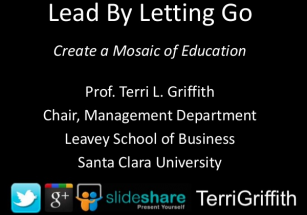A MOSAIC OF EDUCATION
/I'm just back from the Mazatlán Forum, “Technology and the Future(s) of Education: U.S. and Mexican Perspectives.” For three days and a couple of wonderful extra meals, leaders from education, industry, and academia worked to find a more effective future for students in the United States, Mexico, and the world.
"Education Will Be Cloud Based"
Howard Charney, Senior Vice President, Office of the Chairman and CEO, Cisco Systems, gave a clear message to all of us during the closing keynote: Education will be cloud based — the cloud becomes the repository and the structure of education changes. More broadly he noted, "If you think your area of expertise is going to stay unchanged, you're mistaken and you're going to be out of a job.”
We needed to hear this from someone as well versed in both technology and higher education as Mr. Charney. No one in the room denied that most educational institutions have been static for centuries -- San Jose State being an interesting exception, as per Mo Qayoumi's (President, San Jose State University), opening keynote. We were not as unanimous on universities’ need to change, though that was the argument I made in the first of the faculty presentations. I called for us to lead with a lighter touch (my full presentation is below).
"Lead With a Lighter Touch"
Specifically, I said we need to loosen our grip on our:
- Degrees: Move to smaller modules that are available when a student needs the knowledge
- Walls: Offer our modules freely to the world (sometimes free as in "free beer;" but always free as in "free speech")
- Faculty: It is a rare faculty member who is the best presenter across all the topics in a course. Instead, “faculty” for a course or module should be the best on the topic — just as we select readings written by others, we should select presentations done by others if they will do a better job with the material. This assumes share and share alike in that I need to offer my presentations to others (thus, why we must loosen our grip on our walls first).
- Assessments: Faculty-given grades are proxies for student capabilities and not necessarily tied to capabilities organizations are looking for. While we should certainly arrange feedback, organizations or down-stream consumers of student work may be in a better position to assess quality and fit. Educators need to work in partnership with organizations to provide relevant education.
To this last point, one of my colleagues noted that I had a “functional view of education.” To that I replied, "guilty as charged," but that perhaps my view of functional is not as siloed as might be expected. Ethics, self-understanding, critical-thinking, etc. are things organizations want as well.
Don't Let Learning Flatline
Rather than offering lumpy four and two year degrees (for that approach I showed two heartbeats and then a flat-line), we should find ways to provide knowledge when a person needs it (depicted by an on-going heartbeat). The cloud lets the material be always accessible, and then frees faculty to prepare other material rather than repetitively teaching the same topics. More topics go into the cloud and educators spend their non-authoring time coaching, responding, and challenging.
Mosaics are More Nuanced
This last is how I brought us back to the idea of a mosaic of education. Mosaics are not linear, but rather rich pictures filled in by small pieces (in some cases as small as 5000 pieces per square inch). If we think of capabilities being gained over the course of a lifetime — especially if today’s new employees will have 20+ different jobs in their careers — the mosaic form of education allows us to respond to changing needs.
This is a message I’ve shared before, but rarely in a room with so many in position to take action. I look forward to what the future brings.
Many thanks to all the sponsors of the Mazatlán Forum 2014, including (more to come) Art Lund, Casa Lucila, The Jonathon, and the community of Mazatlán.








